Written by John Edward Betancourt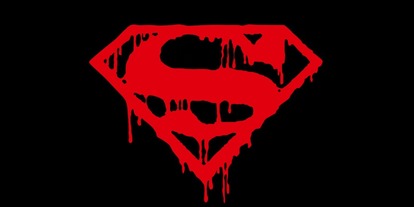 I remember growing up, when DC dropped a massive bombshell on all of us; the fact that Superman was going to die. It was something unheard of at the time, and such a big deal that it managed to make the six o’clock news back in the day and for me, it was a huge deal through and through, and The Death of Superman is still big and sweeping enough for me to go back and revisit whenever I have the time. For those unfamiliar with the story line, buried on earth was a massive and monstrous creature. Covered in thick skin and jutting bone, a being known as Doomsday emerged from the depths of our world to go on a rampage. A monster of incredible power, Doomsday managed to beat down the ranks of the Justice League before finally meeting its match in Superman. But their battle left Metropolis in ruins and worst of all, the world without its greatest hero. When I first heard that the end was near for Superman, I made it a point to know the entire story, after all, this is the first superhero I had ever known thanks to my dad and it only seemed right to know exactly what force in his world could stop a man of steel. Needless to say, I made sure to do extra chores, to earn extra allowance so I had enough cash to grab as many issues of this story as possible, and I was able to get my hands on a back issue of the Doomsday storyline every time my family went to the grocery store since a comic book store was right around the corner. But little could prepare my young mind for the horrors that awaited me in Issue #75, since that was the one that featured the Death of Superman. As a young boy, this is a story that I look back upon with great fondness simply because of the fact that it completely and utterly captivated me. Doomsday was chilling to see on the pages as the writers and artists slowly revealed the creature's hideous form and the fact that it was simply a force of nature in many ways made the story even more incredible. But of course, the big stunner was that Superman was indeed dead. It really didn't seem possible but there he was, lying still atop the ruins of Metropolis as Lois wept. It was a powerful image, a powerful comic series and in many ways, it truly ignited my love for comics with its incredible story arc. I know some people are not fans of this particular moment in DC Comics' history, but for me...it was a bold and powerful story that stunned me to no end and I wasn't kidding when I said that there are times I pull out the trade paperback of the entire saga and find myself in awe once again as I relive the moment when Superman died…
0 Comments
Written by Shae Rufe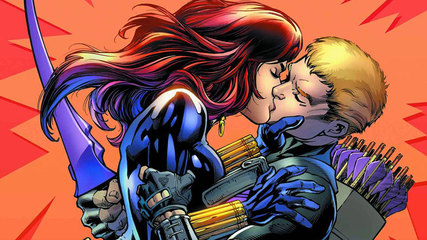 Throughout the history of comics, there’s always been a war. Today the war rages on, mostly between DC and Marvel fans, but really, we’re all geeky nerds, so it’s all in good jest. Last time we explored the romantic side of DC, and today Marvel gets its spotlight time! You know what I love best about superheroes? How they all just date one another. Like, that’s totally cool to just date other superheroes and then move on to the next. I’m sorry, but if my ex-girlfriend was someone like the Black Widow, I’d be terrified to date anyone else ever, or you know, work with said ex still! Yet our superheroes keep it cool, mostly because they’re fictional and subject to author digressions. Speaking of Black Widow, how awesome is Natasha? Depending on the universe, she’s dated quite the list of people. I’m not sure how I feel about her and Cap, but I did adore her and Hawkeye. Let’s face it though, Natasha and Bucky were probably a good pair...they’re actually one of my all-time favorite comic couples, just because. I’m a little wary on the whole Natasha dating the Hulk thing, but, you know, it’s different? Speaking of different, I have to complain. I’m probably one of those rare people out there that hates Spider-Man but absolutely loves Spider-Gwen. Now, hear me out. I actually really like Gwen Stacey as a character. For some reason, Peter Parker is totally tolerable to me when she’s in the picture. Which, yes, alright. I am not a fan of MJ. There, I said it. I don’t like her character at all, but it’s alright. Gwen is just awesome, and the Spider-Gwen comics are really just…a win in my book. However, while I may not be the biggest Spider-Man fan, I have to admit that Peter has gotten some pretty awesome chicks. Mostly, the Black Cat. Felicia may not be for everyone, but this is one of those comic couples that intrigued me enough to go 'huh, maybe this isn’t terrible.' It’s kind of like Batman and Cat Woman….with less gritty violence and betrayal? Speaking of betrayal! Guys! I...literally just lost what I was about to type here. I promise it was going to be clever and funny, but now you’re stuck with me rambling for a moment while I try to figure out where I was going to transition this into. Oh! X-Men: Days of Future Past, the film adaptation took a lot of liberties with the storyline. While it was different and new, the story fell a little shorter than the comic or even the cartoon adaptation. But, since we’re on the subject, can we just talk about Wolverine and Storm? Why was that not a thing? Maybe it is, I didn’t keep up with the X-Men comics, because, look…there’s only so much time in the day! Either way, these two just need to be together. While it’s cute to watch Logan fawn over a very taken Jean, seeing him actually happy with Ororo is kind of better. Granted, I’m biased, but I enjoyed that story line. We also need to talk about Rogue and her tragic love life. Look, Rogue is a fun character, but the girl has the saddest, most isolating, set of powers ever. While she and Gambit will forever flirt and dance around one another, deep down, we all know that they’re also a perfect couple. Not to say Jean and Scott aren’t…I mean, they’re alright. Marvel’s couples get probably more confusing and diverse for me than DC, for sure, but both universes are so expansive it’s hard to keep track. Especially with characters like Hawkeye, who I am pretty sure literally dated every female Avenger, ever. From Black Widow, to Scarlet Witch, to Spider-Woman, and even a failed marriage to Mockingbird, Clint’s extensive list of exes is more impressive than any other comic character. Except Magneto, who literally had how many kids with how many other mutants?! And he’s worked with them all too. I suppose this all stands as a lesson. If you become a superhero, careful who you date? Or more importantly, just date everyone, because why not? Comics have such in-depth characters and relationships that it’s no wonder we fall for them. Yes, they’re awesome and action filled, but comics can also make you feel things you didn’t know possible. And secretly, they sneak love stories into our plot lines without us even knowing it….and so, so, much more. Nerds That Geek Comic Book Review - 'Moon Knight' (2017) #191: 'Crazy Runs In the Family - Part 4'2/22/2018 Written by Joel T. Lewis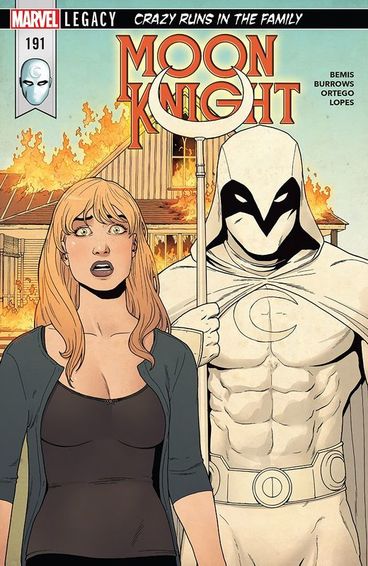 I’ve given up trying to figure out what will come next from Max Bemis’ Moon Knight run. I have no idea. He’s broken the part of my brain that used to speculate about the next adventure my favorite superhero would embark on. Opening his run with a whole issue where Moonie doesn’t show up: brilliant. Giving Bushman a tragic and relatable bit of character development and pairing him with a more dramatic villain: inspired. Having Jake and Marlene raise a daughter behind Marc’s back: fascinating. At every turn, Bemis has defied prediction and made Moon Knight dance in ways I never would have thought possible. So I’ve given up trying to predict the next step in the storyline and I’ve decided to just let Moon Knight happen to me. That being said part 4 of ‘Crazy Runs in the Family’ does not disappoint. After an epic battle of flame and fist, Moon Knight manages to escape the clutches of Bushman and the Sun King with his newly discovered daughter. Marlene, proving herself to be much more than mere damsel in distress by attacking Bushman with a knife, is unable to escape and abducted. As Khonshu explains the history of his ongoing battle with Ra to Marc, Jake, and Steven, the Truth is freed from prison and joins Sun King and Bushman in their plot to set yet another trap for the jet and silver avenger. The issue wraps up as Marc prepares to rescue Marlene and calls upon his oldest and closest friend Jean-Paul ‘Frenchie’ DuChamp to look after his daughter. But while the man who comes to Marc’s door is definitely Jean-Paul, the fact that he appears to be a zombie throws his fitness as a babysitter into question. Do you see why I’ve given up on trying to predict Bemis? The last issue ended with, ‘Surprise Moonie, you are the father!’ and this one dropped the mic with Undead Frenchie. Shut up and take my money Max Bemis. The introduction of Diatrice (Moon Knight and Marlene’s Daughter) and the contrasting innocence she brings into the world of Moon Knight is truly refreshing. Moon Knight has never been a happy comic book hero, and the brief glimpses of kindness and tenderness within his story have been few and far between; his is a universe which was abandoned by innocence a long time ago. Enter Diatrice, a veritable moonbeam (please let that be her superhero name!) of innocence and curiosity who gives the audience a way of discovering a whole new side of Marc Spector. We see through Diatrice how complex and confusing Moon Knight is, how the madness we’ve normalized in our fandom would appear to someone outside of it, but she also brings a vulnerability and tenderness out of Marc. Even as he butchers his explanation of his alter egos, we see him share his music with her in a very intimate and wholesome scene. The normalcy of this domestic scene is something that we’ve never seen in Moon Knight, and it’s something that I never knew I wanted for this character. Twisted and dysfunctional as Marc’s introduction to his own family is, what Bemis highlights in this issue is the potential for a real family connection for Marc in the arcs to come. This is a pretty huge shakeup in terms of motivation for this character, his relationship with Marlene, and how Moon Knight’s vigilante philosophy adapts (if at all) as a father. Jacen Burrows is outstanding as always, playing with fire, Egyptian mythology, and even Cthulhu briefly in this issue (yes reader that’s right, I said Cthulhu). But in this issue Matt Lopes’ colors really stood out for me. The dramatic contrast he plays with within the pastel pallet he’s established is really striking. The heat that comes off of the panels where Moon Knight dodges the flames cast by Sun King and the cool blues that accompany the return of the Truth demonstrate the importance of an exceptional colorist when it comes to bringing comic book panels to life. Also, I cannot get enough of Diatrice’s splash of Pink hair. There is something so punk rock and at the same time innocent about her and it is only elevated by Lopes’ skillful color work. Until next time, Geek On! Written by Shae Rufe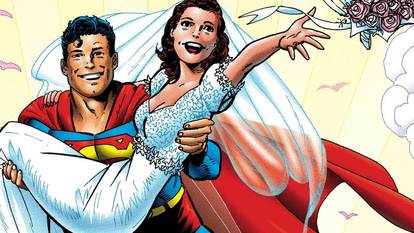 Sometimes obsessions come along, and they hit you in the face like a ton of bricks. My current obsessions are cats (shocker!), Fear the Walking Dead, Steven Universe, Sebastian Stan, and pretty much all of YouTube. Like, literally, that is my life. Perhaps my biggest obsession ever, an always, is love. But Shae, how are you going to make that Nerdy? Well, that's simple actually. Let’s talk about our favorite couples across nerdom, shall we? First, let's get a snack...because, I mean, who doesn't like snacks? First, the ultimate couple, Superman and Lois Lane. It does not get more iconic or nerdy than that, really. And while the New 52 boldly tried to pair the Man of Steel with the Amazonian warrior herself, it didn't really work with a lot of us fans. Granted, I don't really read Superman since he isn't one of my favorites (sorry John!) but seeing him with anyone other than Lois is just weird, even if she is a ginger now. That's the point though, Lois and Clark have had such a long-standing romance spanning their many years in comics, shows, cartoons, movies, and now video games, it's hard to see them with anyone else. And yet, some people enjoyed the new change with Superman and Wonder Woman dating. But it makes me wonder what is Lois doing now? Dating Jimmy? Being dead? Either way, I really can't see a world where Clark isn't with Lois. Unlike Batman who is a total whore and sleeps with a lot of different women, depending on which story line. I always liked him with Selena Kyle. But, they're not my favorite Bat related relationship. If we're going by the comics I pathetically love, more than literally a lot of things (cake), I have to hand it off to Barbara Gordon and Dick Grayson. Comically speaking the two have dated other people, and I really don't care if you say the original Robin belongs with Star Fire or someone else, because you are wrong. This Bat duo is my all-time favorite and really, shouldn't they be everyone's? In my world they are. But I also live under a comic rock and have hardly been keeping up on things, as life is busy, so I will choose to stay blissfully ignorant of any changes to that pairing what so ever. Speaking of changes, Poison Ivy and Harley? Dating? I'm not against it in the least, I'm just a little concerned our crazed psychiatrist left her beloved Joker. Ivy isn't as violently crazy, but she certainly has a few screws loose...so maybe they're perfect for each other. This blog is strangely D.C. related...it's okay, Marvel will get their own blog! Because what love inspired, D.C. centered blog would his be if I didn't mention one of my favorite archers and his girlfriend. Green Arrow and Black Canary are probably right up there with Nightwing and Batgirl. Don't ask me why, because I have no idea, but these two stole my little Shae heart and ran away with it. They're utterly adorable. Yes, Olly has had his flings with the ladies, and while I loved Arrow and I adored Oliver and Felicity, the comics where Black Canary and the Green Arrow end up together are forever a top favorite of mine. Of course this is all my little Shae opinion, of which are now law, because I have decided to run for supreme dictator of the world. And by run, I mean nominated, voted for, and elected myself. These are the types of things that get said in the strange hours of the night. But really, a second part will follow, because we know I can't just rant about one subject and be done. Written by Zeke Perez Jr.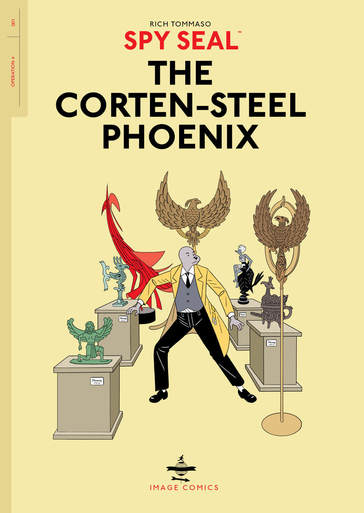 I’m starting to wonder whether we need to reconsider how we use the old saying ‘don’t judge a book by its cover.’ I mean, sure, it still applies to people and - in most cases - books. But it definitely doesn’t work for comics. Ignoring that adage allowed me to stumble upon Rich Tommaso’s Spy Seal series. I was strolling through Mile High Comics in August, hoping to scratch the itch for a new series to follow. I was growing tired of following the same heroes and the same universes. I wanted to find something different, something unlike what I typically read. I scanned the rack of new releases and instantly found just that. Bright colors, amazing design, fun characters, a compelling title. Judging it solely by the cover, Spy Seal: The Corten-Steel Phoenix seemed to be among the most incredible comic books I had ever seen. I’m not sure which aspect of the cover drew me in first: the exuberant colors or the title character. Either way, I was sold! Who doesn’t want to read a story about an anthropomorphic seal leading a life of espionage?? Immediately upon cracking the cover, I knew I made the right choice about picking it up. The story begins with a conversation between the titular protagonist, a seal by the name of Malcolm Warner, and his bird friend Sylvia. They discuss current events and the struggles of the oppressed working class in their country. The juxtaposition of cartoonish animals discussing high-level politics was unexpected, but I found it hilarious. It set the tone for the spy tale that was to come. 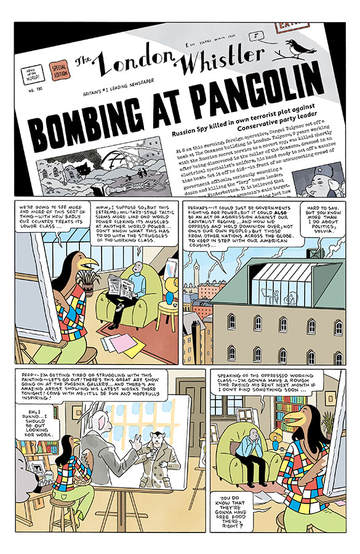 Between assassination attempts, chase scenes, gadgets, and hand-to-hand combat, Spy Seal presents an exhilarating spy story. Tommaso alternates between stretches that are very dialogue-rich and multiple shorter panels with no words and all action. The text-based panels tend to be a bit wordier than what you might typically expect from a comic, but they read smoothly and the story flows well. I also truly loved Tommaso’s art and coloring. His artistic style is reminiscent of European comics, often appearing as a dead ringer for The Adventures of Tintin. The vibrant pastels made each cover and page pop. (My personal favorite was the cover for issue 003; a train rolling through a snowy mountain pass.) Even the inside covers feature unique and delightful patterns. In addition to the crisp characters and landscapes, I credit Tommaso for his attention to detail in each and every scene. Everything from paintings in the background of an art gallery to city skylines draws the reader’s eye, thanks to the nuances in each panel. Rich Tommaso is currently at work on the next chapter in Malcolm Warner’s life: Spy Seal: The Flight of the Golden Bells. In the meantime, I wholly recommend giving Spy Seal: The Corten-Steel Phoenix a read. The four-part series, labeled 001 through 004 in true spy fashion, is available today in a trade paperback collection. And not just a normal TPB either. The collection comes in an oversized ‘French album size’ book. Tommaso wrote, illustrated, colored, and lettered the entire work himself, a grand feat made all the more impressive by the quality of the series. Head to your local comic book shop or bookstore today to pick up the Spy Seal series, not only to find out why it made a number of ‘Top Comics of 2017’ lists, but to support a solid all-around comic artist. Nerds That Geek Comic Book Review - 'Moon Knight' (2017) #190: 'Crazy Runs In the Family - Part 3'1/9/2018 Written by Joel T. Lewis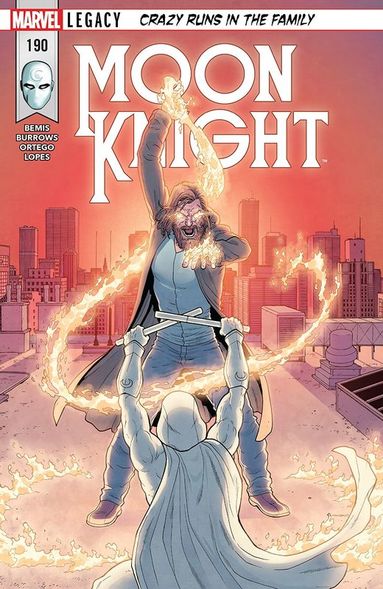 At the conclusion of last month’s issue of Moon Knight, I was left wondering what had happened to Bushman that caused him to become the pudgy sweat-pants wearing drug dealer that Jacen Burrows brought to life on that final page. Max Bemis wastes no time in answering that question: Moon Knight happened. Bemis paints an almost pitiful picture of the once mighty Raoul Bushman, acknowledging his stint as an African Warlord in the 1989 Marc Spector: Moon Knight series, confirming that he was murdered and had his face removed by Spector in 2006’s Huston Run, and that he was resurrected and had his face reattached in 2009’s ‘Vengeance of the Moon Knight’ series. Bemis’ Bushman bears all of the trauma that the different stewards of the Moon Knight mythos have put him through and the pudgy damaged man that remains is unique among the villains of the comic book world. Bushman is terrified of Marc Spector. He tells us so himself in issue 190. And I have to be honest, as I read his stirring and emotional speech to his army of Spector’s victims (a horde of street hoods left disabled and maimed by Moon Knight over the years) my first instinct was to sneer and turn up my nose. I actually thought, ‘Well that’s just a complete misunderstanding of the character.’ I don’t know what gives me the right to think something like that. The fact of the matter is that until Bemis came along, Bushman was a one-dimensional figure of terror. Ruthless, bloodthirsty, and cold. When Marc finally killed him in 2006, though the image was disturbing, I relished that the monster had been given a fitting end. Bemis on the other hand has given us a Bushman who’s just as damaged as Marc is, perhaps even more so as his resurrection came at the hands of a villain called the Hood who used the powers of Dormammu (probably the result of a bargain of some sort…pauses for laughter), a force more sinister than that of Khonshu. Bushman is still a monster, but he’s now a more relatable, fractured monster and that’s a breath of fresh air. Bemis is great at throwing our preconceived notions about our favorite jet and silver avenger out the window, especially when he shows us the multitude of street hoods missing limbs, eyes, and fingers courtesy of old Moonie. When reading a Moon Knight Comic, you don’t really stop to think about the maimed and abused ‘thugs’ that Spector leaves in his wake, you just revel, as he does, in the brutal violence Khonshu requires as tribute from his priest. Bemis reminds us all that Spector cuts a more gruesome path through the New York City Underworld than Spidey, Daredevil, or even the Punisher. Moon Knight’s victims (at least since Huston’s run in 2006) bear the brunt of Marc’s vigilante Justice with crippled limbs, missing eyes, limps, stumps, and scars. This reminder reframes the beloved carnage that has been associated with Moon Knight as even more cruel and poignant than ever before. 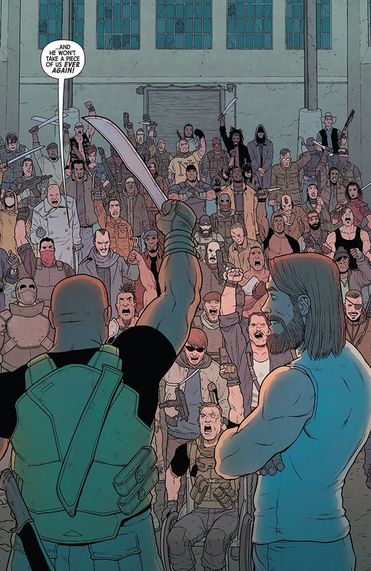 Bemis is having a lot of fun with the tenuous team-up of Bushman and the Sun King, and the way those two interact with each other is really interesting and entertaining. Bushman doesn’t buy into the Sun King’s literal door-to-door evangelism and plays down his partner’s crazed pontificating but at the same time Sun King reins Bushman in when he starts monologue-ing. The two do a great job of interrupting each other when they start to descend into tired comic book villain tropes and that’s a really subtle and clever nuance to Bemis’ writing that really impressed me this issue. In this issue, Sun King and Bushman recruit an army of Moon Knight’s former victims and plan to use Marlene as bait in a trap for Marc Spector. When they arrive at Marlene’s suburban home they quickly discover they have a lot more leverage than they thought. Meanwhile, Marc quite literally wrestles with himself within his mind as he struggles to reason with his Jake Lockley personality and discover the awful secret that the Truth had seen in the previous issue. This sequence is a lot of fun to read as artist Jacen Burrows gets his first crack at the inside of Spector’s head, shifting between scenery, color, and tone effortlessly. These internal glimpses are punctuated by panels depicting Spector calmly mediating in central park, and then shouting at himself. This frightens an elderly lady walking her dog near Marc and the effect is really fun and lighthearted. Marlene, who has been estranged from Marc for about 5 years at this time, is forced to invite him back into her life as Bushman and the Sun King lie in wait. Spector arrives, springs the trap, and the Sun King reveals that not only does he have Marlene held hostage, but he also knows Lockley’s secret, and it’s really messed up. Turns out that Jake Lockley has been seeing Marlene behind Marc’s back for about 5 years. And pretty early into that 5 years Marlene had a child. A child that Lockley and Marlene have been raising in secret behind Marc Spector’s back. That’s right: Moonie’s got a five-year-old girl that he had no conscious knowledge about. I had not fully grasped how literal Bemis’ title of ‘Crazy Runs in the Family’ was going to be until I reached this final page reveal and boy did it throw me for a loop. What a great way to shatter the illusion of conscious harmony in Marc’s head and redefine the relationship between Marc and Marlene in one page! With one swift motion Bemis has linked these two characters together with a bond that is so much more nuanced, complicated, and realistic than has ever been written between them before. This creative team continues to blow me away with their balance of poignant and playful moments and Bemis in particular is just making Moonie dance by shaking up the formula and reframing his relationships and rogue’s gallery. I can’t wait for the next issue! Until next time, Geek On! Written by Joel T. Lewis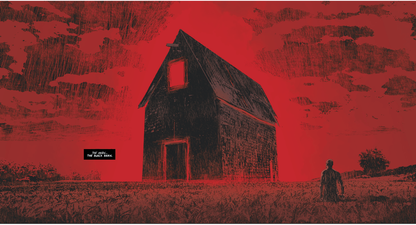 In a comic that feels one-part Preacher one-part urban dystopia, Jeff Lemire brings his mastery of small town settings and bizarre supernatural elements to haunting fruition with the first issue of Image’s new Horror series Gideon Falls. Partnering again after their 20-issue tenure on Old Man Logan, Lemire and artist Andrea Sorrentino masterfully pair meticulously rendered texture with an eerie foreboding tone. Following the story of the newly appointed Gideon Falls Priest Father Wilfred, who steps in after his predecessor was mysteriously killed, and that of the mysterious junk collector Norton who scours a crumbling cityscape for artifacts that seem to be imbued with strange significance, Lemire and Sorrentino balance two very different settings. Norton’s cityscape, his barricaded apartment, and even his therapist’s office seem dystopically derelict and as he moves through the gaps between the skyscrapers donning his surgical mask, Norton’s surroundings seem to weigh on him as heavily as his clear neuroses seem to. And while Sorrentino’s vision of the rural town of Gideon Falls has a bright crisp aesthetic, courtesy of some exceptional color work by Dave Stewart, the little town shares the same sense of crumbling decay, perhaps not as visible but there’s certainly something under the surface of the chapel and the dried out paint of the school bus that Father Wilfred passes on his way into town. Lemire is no stranger to the supernaturally bizarre small town setting. Royal City, Essex County, and Underwater Welder all dealt with this mysterious tight-knit type of community with its own intricacies and mystery. But by substituting a more sinister, rather than Lemire’s signature melancholy, supernatural element and interjecting Norton’s urban collector psychosis between the pages set in Gideon Falls, what emerges is very unique and innovative. An extension and perhaps a skilled variation on the theme of the supernaturally coded rural community, Gideon Falls could have felt as if Lemire was reluctant to leave his comfort zone. Those of us familiar with the breadth of Lemire’s body of work from Moon Knight, Descender, Trillium, Sweet Tooth, and a multitude of others know that that’s not the case and this series feels fresh and exciting. Sorrentino’s artwork, it’s texture, the way he designs his panels; it’s all exceptional. It’s particularly exciting to see that after his work on a character with as much design potential as Wolverine that he brings the same care, severity, and detail to elevate the grounded human characters of this new book. His splash pages are gorgeous and it’s astounding to see the juxtaposition of his rural and urban panels one after another each playing off and inverting the one that came before. Gideon Falls is haunting, gorgeous, mysterious, and perfectly positioned to join the ranks of the growing number of successful Horror titles coming from Image Comics. Until next time, Geek On! Special Thanks goes out to Jeff Lemire for providing Nerds That Geek with an Advanced Copy of Gideon Falls #1! Written by Joel T. Lewis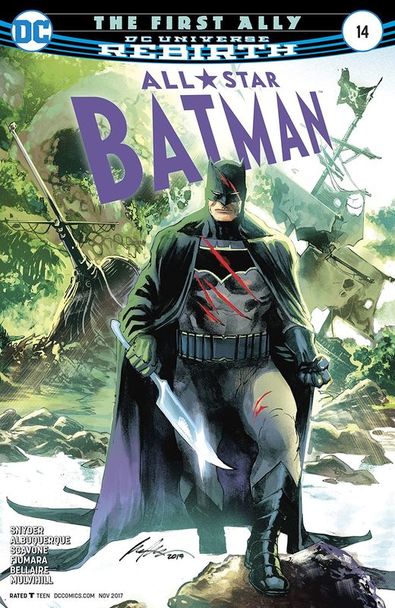 I can’t quite explain to you, dear reader, why it’s taken me so long to write my final review for Scott Snyder’s All-Star Batman series. Perhaps I was disappointed that it didn’t quite stick the landing for me, maybe I grew to begrudge Snyder’s panel choking dialogue, exposition, and narration, but I think if I’m really honest with myself it’s because I was so sad to see it go so soon. Tom King is writing an exceptional Batman, and I believe that his tenure on the flagship title (‘The War of Jokes’ and ‘Riddles’ arcs especially) will go down in history as one of the most important periods in Batman’s history, but no Batman run that I’ve ever read has been as fun as All-Star Batman. All-Star Batman was a slightly lighter Dark Knight, and what a breath of fresh air that was. He quipped, he smiled, and you really got the sense that for this Bruce Wayne his mission wasn’t just a burden he’d taken on to keep his promise to his parents, it was something he was good at, it was something he loved to do. Pirates, Ice-Zombies, Snyder even gave us Shark repellent. And while the dramatic conclusion of this swashbuckling pirate arc ‘The First Ally’ fell a little flat for me with the revelation that the man behind the Black Knight was an Alfred clone and Snyder beating the Pirate story analog to death, this arc and its conclusion was a lot of fun and had a hell of a lot of heart. Snyder thoroughly explores the power and familial dynamics of the father-son relationship through the multigenerational pairings that he’s set up over the course of this final arc. The tension between Alfred and Briar, who’s possessive and manipulative influence on Alfred is in direct and extreme contrast to the aloofness of Alfred’s actual father culminates in Alfred’s violent rejection of Briar’s Black Knight mantle. This rejection by a promising pupil, and in a very real sense, a surrogate son, drives Briar to create an imperfect clone of Pennyworth whose own father-son relationship with Briar is even more unhealthy. Constantly compared with and never living up to the original Alfred, the clone, turns on Briar in a last-minute epiphany which, funnily enough, fulfills Briar’s own twisted hopes for Alfred. By killing Briar, the Black Knight rejects and frees himself from the only familial attachment he had (however traumatic an influence that attachment was). This was the key to becoming Britain’s purest servant, the Black Knight, at least as far as Briar was concerned, and his second surrogate son surprised him by fulfilling that criteria. 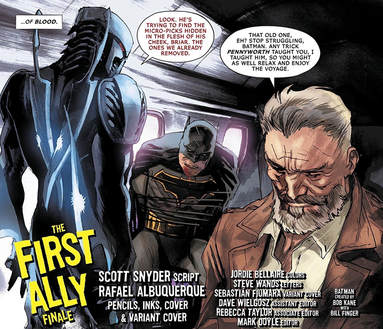 Snyder also gives Alfred closure as he discovers a stack of letters addressed to him but were never sent by his real father Jarvis at the same moment he is introduced to Bruce Wayne for the first time. This cycle of father-son dysfunction and equalization is skillfully executed and adds yet another layer of intimacy to the Bat-Family dynamic. One that, in my opinion, was a long time coming. The love and understanding conveyed in that final embrace as Bruce and Alfred stand in the shadow of the Batcave is completely earned and really satisfying as a devoted reader and fan of Batman. While juggling these intricate and complex paternal dynamics, Snyder manages to pepper in some of the best lines Alfred has ever spoken. I loved, ‘Ahoy @#$%! I got your Tea right here!’ in particular as Alfred swoops in via biplane to respond to Briar’s comment amount the domestic turn Pennyworth’s life has taken. But there’s one line in particular that hammers home Snyder’s understanding of the power of the Batman narrative in popular culture and shows his skill when wielding it. Sitting behind a bristling biplane-mounted machine gun Alfred tells his former mentor, “Well, there’s a saying in this country, Briar. ‘Always be yourself. Unless you can be Batman.’ But sadly, I can never be Batman. Because Batman doesn’t use guns.” Never in my life would I have thought I would get to hear the words of a meme of all things come out of Alfred Pennyworth’s mouth. It was glorious and it shows again how comfortable Snyder is writing Batman. He knows that character, he knows the character’s fans, and knows how to balance fan service and serious content. I loved All-Star Batman, not because every issue landed for me, or because it’s the purest representation of the Dark Knight, it’s because it’s featured the Batman who’s had the most fun and I’m going to miss it. Until next time, Geek On! Written by Zeke Perez Jr.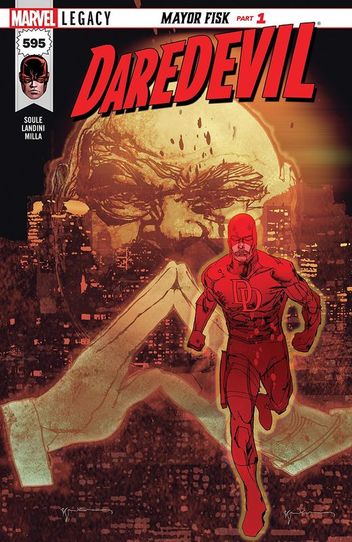 I typically tend to review a comic series after it is released in its entirety, rather than on an issue-by-issue basis. But every now and then, an issue or story arc comes along and I just can’t wait. I want to tell the world about it right off the bat. Enter the ‘Mayor Fisk’ arc in the current Daredevil run (beginning with Marvel Legacy’s Daredevil #595). Recent Daredevil comics have been grounded in reality-driven storylines, as the lives of superheroes intertwine with human politics. The preceding - and equally wonderful - ‘Supreme’ arc follows Matt Murdock as he argues a Supreme Court case that legitimizes the role of superheroes in the legal system, allowing them to act as more than vigilantes by granting them the ability to appear and testify in court. In ‘Supreme’, ‘The Kingpin’ Wilson Fisk attempts to have Murdock taken down in court by a competing lawyer and out of court by an assassin. Now, the ‘Mayor Fisk’ arc builds on that as Fisk attempts to turn the entire system against Daredevil. The shift to Fisk as Mayor is sudden. In fact, you learn that Fisk was elected within the first couple pages of the issue. Murdock suspects foul play and corruption, immediately going to work to challenge the election results and to preserve the legal winnings he achieved in ‘Supreme’. Meanwhile, Fisk has turned the city’s police force against Daredevil and seeks to turn the populace against him too. Fisk claims that he and the people of New York want to take a stand against Daredevil and the other heroes that are ‘invading their lives, destroying their property, bringing chaos and terror’. The issue concludes as the two face off with Fisk promising to use everything in his power as mayor to stop Daredevil, and Daredevil hoping to take that very power away. 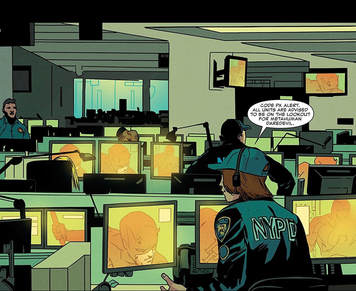 Heroes vs. civilians has risen as a central theme in plenty of media. Batman v. Superman: Dawn of Justice, Captain America: Civil War and the Civil War comics, and many others touch on it. I would argue that few have presented this battle better than writer Charles Soule has in both ‘Supreme’ and the first issue of ‘Mayor Fisk’. Soule leans on real-life issues to create gritty stories that feel genuine, interesting, and exciting. While court cases and municipal elections might not immediately come to mind when thinking of a superhero story, Soule’s writing produces deep and riveting plots that rival any action-centric comic. Artist Stefano Landini and color artist Matt Milla do a fantastic job illustrating the comic. Daredevil and the Hell’s Kitchen landscape both have a very classic feel to them. Additionally, they’ve done an exceptional job portraying Fisk himself. In other depictions, Fisk has looked bulky or abnormally big. The Kingpin of the ‘Mayor Fisk’ arc looks powerful yet human, his facial expressions giving him a chilling edge. It is one of the best depictions of Kingpin that I’ve seen. Daredevil #596 - the second issue of the ‘Mayor Fisk’ arc - comes out today. It’s not too late to jump into this storyline. The arc will run for five issues total, concluding in February. If you want catch Fisk’s mayoral term on the front-end, head to your local comic book shop today. Happy New Comic Book Day! Nerds That Geek Comic Book Review - 'Moon Knight' (2017) #189: 'Crazy Runs In the Family - Part 2'11/30/2017 Written by Joel T. Lewis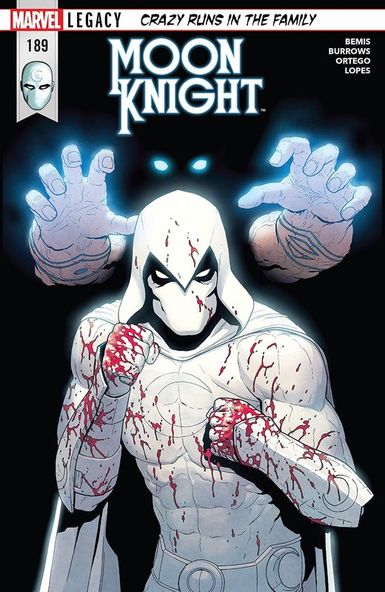 I’m not sure if it stems from my unbridled fandom of Moon Knight, or Max Bemis and Jacen Burrows are just that good, but Moon Knight delivered another incredible issue this month. Beginning with a cold open introduction to a new villain calling himself the Truth (readers of my last Moon Knight review will forgive my mislabeling of the previous issue’s villain as the Truth as I have found out recently that patient 86’s villain name is the Sun King) and concluding with the surprise reveal of an old rogue’s gallery favorite, Bemis and Burrows have done it again. In an issue that introduces the Moon God Khonshu as a, dare I say it, whimsical narrator, Bemis maintains the poignant and playful tone of the previous issue. We are reintroduced to Moon Knight’s Steven Grant persona, who Bemis has described as an investor and entrepreneur, rather than the Hollywood movie producer that Lemire had built him up to be. Even after the lengthy sabbatical that he had taken while Spector sought the therapy he needed to accept rather than resent the aspects of his mental condition, Grant managed to double his own wealth in addition to boosting his corporation’s already healthy bottom line. The next few panels show us that every cent of Grant’s gains from his fancy stock footwork is going straight to a charity fund for New York’s displaced young people, a fund called the Lunar Lives Fund. Seeing the effects of the Truth’s attack on the subway on the TV at Grant’s corporate celebration, he rushes off to investigate. In this section Jacen Burrows artwork really shines. The combination of his pencils with newcomer (at least to Moon Knight anyway) Inker Guillermo Ortego just leap off the pages. Burrows crafts some soon-to-be classic Moon Knight panels and just nails the character design across the board; in motion, covered in blood, shrouded in darkness, he’s just so spot on. I enjoyed the subterranean panels in particular because of the tone shift colorist Mat Lopes was able to achieve as Moon Knight moves through the low light of the subway tunnels. Moon Knight meets and tussles with the Truth in the cavernous tunnels, stumbling slightly as the villain attempts to subdue his mind to his will. The Truth’s powers, though effective at imposing his will and warped view of the world as unworthy of continuing on the citizens of New York, he finds himself unequal to the task of overpowering a mind as crowded as Marc’s. Though Marc, Steven, and Khonshu are unable to resist the Truth’s prying mental manipulations, once he transitions to his Jake Lockley persona, Moon Knight dispatches the villain quickly. When Jake takes over, Moonie pulls back his hood and uncovers his mouth, a variation on the Mr. Knight identity introduced in Secret Avengers (2012) no. 19 by Warren Ellis and Michael Lark, which would be brought to the forefront of the Moon Knight solo title by Ellis in 2014. The Truth’s terror at the ‘truth’ he finds in Jake’s head disarms him enough that he leaves himself open to double crescent moon darts plunged into his eyes. But not before revealing that perhaps Lockley has been keeping his more gruesome actions secret from Marc and his other identities. The ambiguity of Marc’s sanity and grip on the actions of his segmented personality is a classic element of Moon Knight stories and I’m really fascinated by the notion of Jake, rather than Khonshu, using his position inside Marc’s head as a vehicle for carnage and chaos. It will be really interesting to see how the Marc/Jake dynamic plays out in the issues to come. 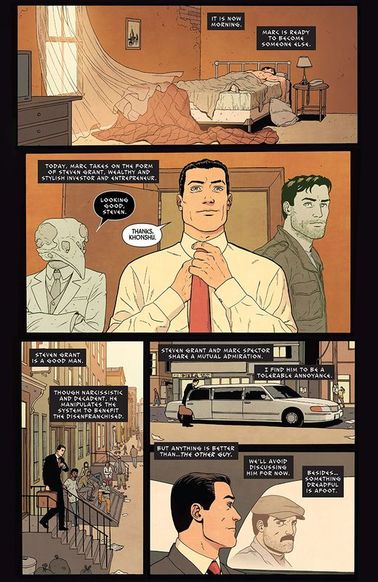 Interspersed throughout the issue are panels that follow the mysterious patient number 86 from the previous issue, (also known as the Sun King) on his search for a faceless Drug Lord. As the Sun King moves through the New York underworld, gaining information through his charisma and power over fire, the contrasting color scheme of the panels mirror the otherworldliness of his character, and the nature of his powers. The gray tinge that all other characters have in these panels contrasts beautifully with the fiery orange aura that Mat Lopes gives the Sun King. Finally, as the Sun King finds the elusive Drug Lord he’s been searching for, Bemis and company reveal the mystery man to be an overweight, sweatpants wearing Raoul Bushman. This was a surprise. Especially considering my respect and fear of Bushman, seeing him let himself go, was a little disheartening. This is a man who slaughtered villages without prejudice and would bite out people’s throats with relish, so to see him drawn pudgy and wearing track pants made me a little sad. I am really curious to see how he will work in conjunction with the upstart Sun King, and also whether or not Bemis will fill us in with what Bushman’s been up to since Spector’s rebirth and how he came to let himself go so dramatically. Bemis’ interpretation of how Marc interacts with his separate personalities, and his characterization of Khonshu in particular is fascinating. By showing ghostly representations of his other personalities as they speak to each other, Bemis has laid out an easily followed road map to Marc’s psyche that helps the reader understand who’s speaking to whom and where Marc is in terms of his control of a situation. Also, when Marc addresses Jake saying, ‘What was he talking about Jake? This is exactly what we agreed not to do! We will talk about this later.’ His tone is like that of a frustrated father, trying to rein in an unruly child, which is a very interesting dynamic for those two personas to share. Khonshu as a narrator is almost cheerful, complimenting Steven Grant and commenting on his dislike of the Jake Lockley persona. It’s almost as if Bemis has modeled the vengeful god in his version on Batman’s Alfred; he’s snide, knows his avatar perhaps better than he knows himself (or selves), and, thus far, has only spoken or acted in an observational and advisory capacity. I don’t think this is the wrong direction for the character, but it seems to disarm him a bit, which might be the point. Gone are the days that I forget what Khonshu is and has always been; manipulative, vengeful, and unpredictable. I certainly learned my lesson about underestimating him from the last series. More remarkable than the levity and personality that Bemis brings through his narration of the issue, is that he’s nailed the old school Moon Knight quippy-ness of Doug Moench’s original series without it feeling out of place or dated. Moon Knight addresses the Truth before attacking him, ‘You. Before I knock you out, tell me…do you need to be called anything?’ This sounds like a classic Moon Knight line, but it’s updated to show that while Moon Knight couldn’t care less what the Truth calls himself, he understands that a villain with a persona craves to be labeled as such. And Moonie is happy to oblige before punching him in the face. Burrows and Bemis continue to do right by Moon Knight and I’m sad that after this issue they’ll be returning to releasing only one issue a month. Alas, I shall have to wait. Until next time, Geek On! |
Archives
May 2024
|
|
© 2012-2025, Nerds That Geek LLC.
All Rights Reserved. |
uWeb Hosting by FatCow
